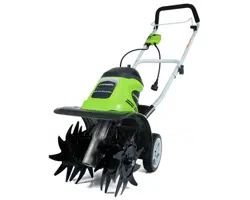Loading ...
Loading ...
Loading ...

18
OPERATION
PREPARING THE SEED BED
The cultivator can be used to break up garden soil and prepare a seedbed for planting. Plan
ahead to leave enough room between the seed rows to allow for machine cultivating after the
plants have grown.
TILLING SOD:
Tilling sod into the soil is not recommended. If sod must be removed to perform application then
it is suggested to do as follows:
1. Map out the area of sod required to be removed.
2. Cut into 16 x 36” sections using a spade shovel or edger at a depth of 3 inches.
3. Lift the sod from the edges using a shovel sliding below at the roots.
4. Remove the sod. Carry sod to compost or other pile turned grass down to allow grass to
decompose.
5. Once sod layer is removed, begin to till the soil to desired depth.
GENERAL TILLING/CULTIVATING
Shallow cultivating (less than 2” [5 cm] deep) can be used to disrupt weeds and aerate soil with-
out injuring nearby plant roots. It should be done often so that weeds do not grow large and get
tangled in the tines of the tiller.
The two inner blades can be removed from the unit to allow a narrower cultivating width. See
pages 17 for correct tine installation process.
1. With the wheel assembly installed to the desired depth position as described on page 14,
roll the tiller to the work area.
2. Route the extension cord through the extension cord retainer as shown on page 11.
3. Plug the tiller into an approved extension cord.
4. Stand behind tiller, with tines on ground and the work area clean and free of obstructions.
5. Start the tiller using directions from page 18.
NOTE: It may take several passes over the same path in order to reach the desired depth. Do not try to dig too
deep on the rst pass. If the tiller jumps or bucks, allow it to move forward at a slightly faster pace. In order to
dig more deeply, lift up on the handlebar pushing the front harder into the ground. Apply downward pressure
on the handlebar, pulling unit down towards you for more shallow cultivating. If the tiller stays and digs in at
one spot, try rocking it from side to side in order to start it moving forward again. If the soil is very hard, water it
a few days before cultivating. Avoid working soil that is soggy or wet. Wait a day or two after heavy rain for the
ground to dry.
IMPORTANT: If weeds, roots, vines or other growth gets collected around the bottom of the tiller
it is important to stop tiller. Disconnect from power source and clean tines using a screwdriver or
other object which can help remove debris. If necessary, removes tines to untangle debris from
shaft and tines.
QUICK TIPS:
Remove rocks and roots before tilling in order to prevent damage to the tiller. Work the soilwhen
it is neither too wet nor too dry. To test the moisture level of the soil, take a handful of soil and
squeeze it. If it remains in a tight ball when you release your grip, it is too wet. If itcrumbles, it is
ready to till. Dry soil is difcult to cultivate, and valuable topsoil can be blownaway when tilling on
a windy day. Fall tilling presents many advantages over spring tilling. Iteliminates the need to till
in the spring, and it allows for earlier planting. Soil moisture andtemperature conditions are favor-
able for decomposition of the organic matter that is turnedunder in the fall. Furthermore, disease
organisms, insects, and perennial weeds can bereduced by tilling in the fall.
Loading ...
Loading ...
Loading ...
